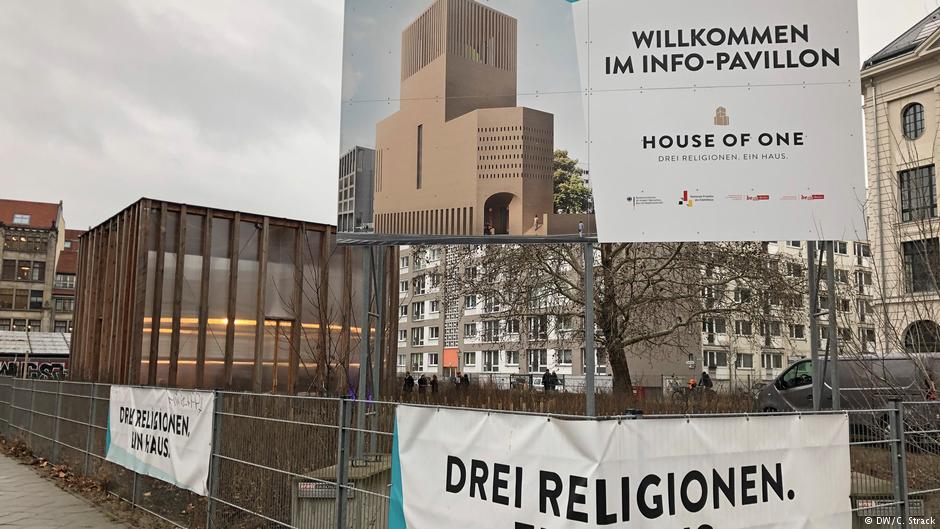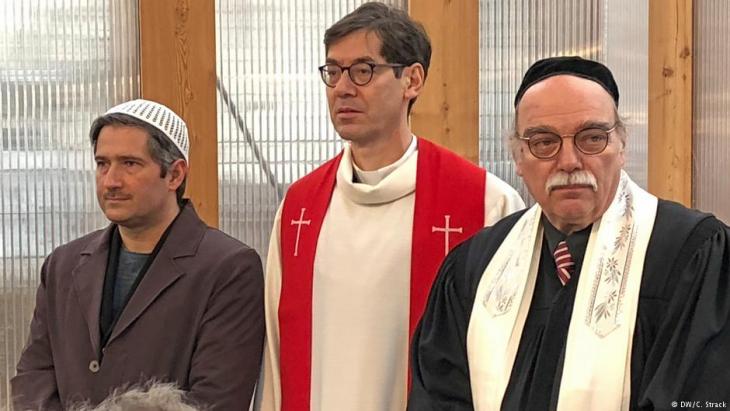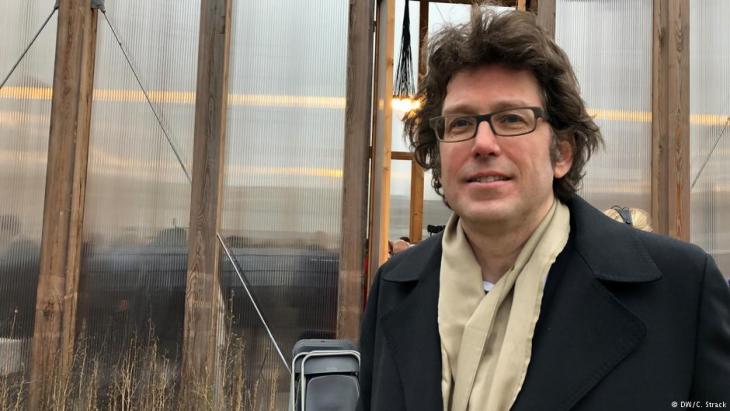Offering a triune solution

Outside: the roar of the city. Petriplatz is situated on one of Berlin’s busiest major roads, six lanes of slow-moving traffic. Inside: the interior of a pavilion made of wood and plexiglass. The cold January wind blows through the cracks.
After a good twelve months or so, around 100 people have come to bid farewell to this information pavilion. Building work is about to start on Petriplatz, which is surrounded by 20-story East German tower blocks from pre-reunification days, new hotels and the shells of buildings under construction. The pavilion will be taken down in the next few days. And then the diggers will move in.
Church, synagogue, mosque
In a few years’ time, a globally unique project will stand here: the "House of One". A joint domicile for Christians, Jews and Muslims, comprising a church, a synagogue and a mosque. Three spaces connected to a central communal room. "This building," says Rabbi Andreas Nachama, "will send out a signal that the three religions can live together, work together."
It will soon be ten years since active representatives of the three monotheistic religions joined together to start an initiative for this communal building. The initiative became a foundation which is now well-respected in the city. And the idea became a design. For a long time, the plan seemed like an ambitious dream; the building – the model for which has already been exhibited internationally in Chicago and Paris – is special. Deep underground it preserves the archaeological remains of the city’s history and the various churches that were built, destroyed, rebuilt or bombed here. Above ground, it will rise some 32 metres into the sky, becoming a symbol of co-operation.

The planned cost of the build is around 43.5 million euros. But donations are pouring in from various countries. In autumn, the German Federal Government promised to contribute ten million euros, if the state of Berlin and individual donations could match that funding. Now the foundation stone is due to be laid on 14 April 2020.
The Ring Parable
This date was chosen very deliberately. 14 April 1783 saw the premiere of "Nathan the Wise" in Berlin. The great play by Gotthold Ephraim Lessing (1729-1781) is probably the most important work of classic German-language literature on co-operation between Jews, Christians and Muslims. Lessing uses a "Ring parable" to explain that God loves all three monotheistic religions – and they are therefore duty-bound to be tolerant.
"The Ring Parable is almost too perfect for the idea of the 'House of One'," says Ulrich Khuon, the artistic director of the Deutsches Theater Berlin, who attended the ceremony. He likes the connection. The respected director then moves on from the situation in the roaring city and among the towering buildings to talk about the three religions. The strength of the three religions in this place may, he says, "lies – like the strength of art – in their virtual powerlessness and weakness, not in the manifestation of strength and suppression and significance, of power."The idea of the "House of One", the place, the ceremony – it suits Berlin, which as a city upholds its secular character and yet offers a multiplicity of religions. In the pavilion, you can see Jewish kippahs and Islamic skullcaps. In the front row, the Bundestag’s vice president Petra Pau from the left-wing Linkspartei is sitting beside the publisher Friede Springer and Sawsan Chebli, the Muslim Social Democrat and State Secretary in Berlin. The government’s Commissioner for Jewish Life in Germany and the Fight Against Anti-Semitism is playing the violin in the string quartet, and elucidates the spirituality of the music.

Rabbi Nachama, the evangelical Minister Gregor Hohberg and Imam Kadir Sanci sing prayers and ask for blessing for the project. "We pray for those who have responsibility in politics, religion and society, for Berlin, our country, Europe and the world."
Then there are speeches. Berlin’s State Secretary for Culture, Gerry Woop (Linke) says that the planned building will be a "site of religious co-operation and coming together". And he speaks of "outstanding architecture in one of the city’s central squares."
An architect in dialogue
Wilfried Kuehn is pleased. The Berlin architect whose design won through in an international competition, is planning the building everyone is now praising so highly. "Sacred buildings in themselves are always a challenge – one of the most enjoyable challenges there are," he says in conversation with Deutsche Welle. "We’re talking about a space that isn’t founded on practicalities, but on ideals and ideas, similar to art and music."
And then he tells us about the collaborative work on the "space allocation programme" for the "House of One", always in dialogue with the three religions. "And each time, we all discuss everything. Which is to say: we don’t talk to the Imam about the mosque and the Rabbi about the synagogue and the Minister about the church; we speak to all three about all the spaces. And that gives us a very interesting dialogue already, at the planning stage, which actually anticipates the character of a building like this."
The building will begin to grow in April 2020, and the "House of One" is due to open in 2023. "Of course," says the architect, looking at this unique project, "it’s also incredibly beautiful. Because they are experiencing their vocation on a deep level that is rarely possible elsewhere." Despite the roar of the city on all sides of the site.
Christoph Strack
© Deutsche Welle/Qantara.de 2019
Translated from the German by Ruth Martin